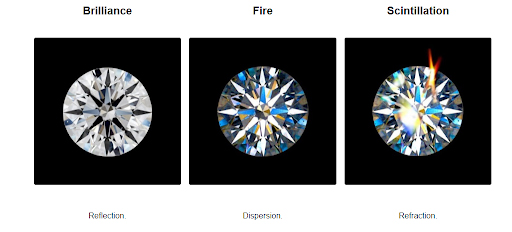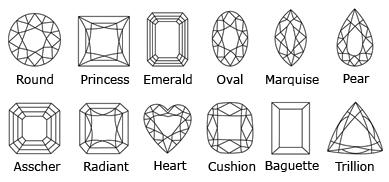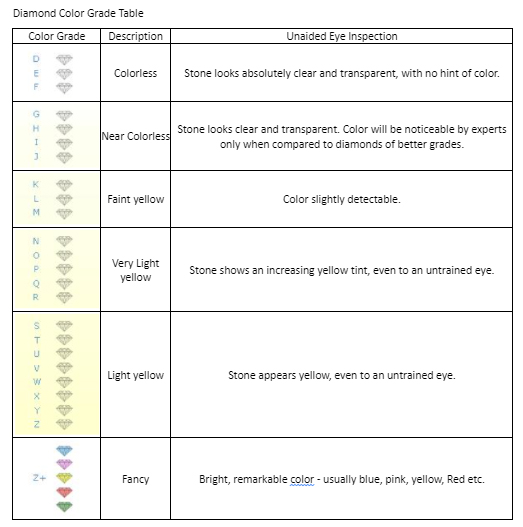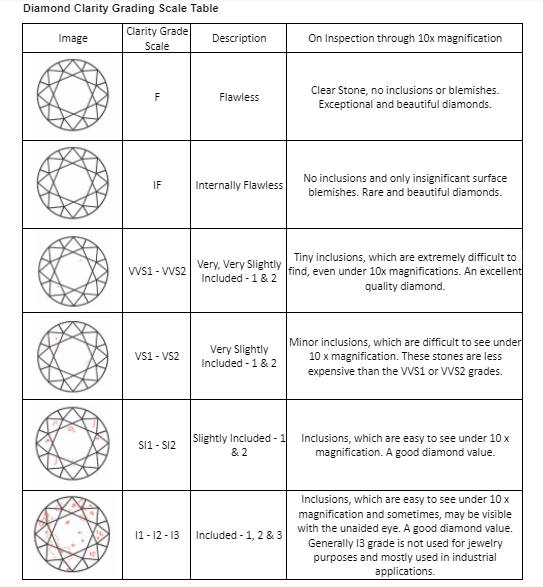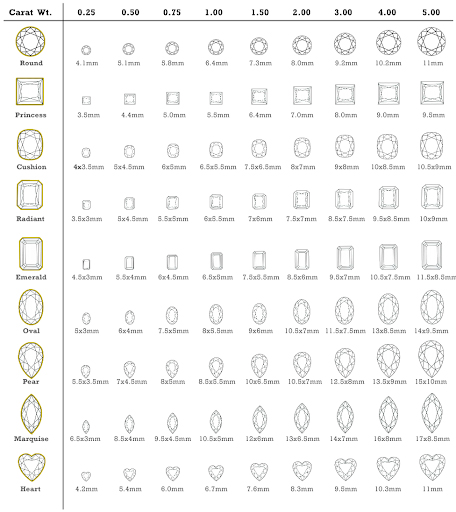There are Four Types of Diamond 4C:-
- Cut
- Color
- Clarity
- Carat weight
1) Diamond CUT
A diamond's cut is the most important property to enhance its beauty because a well-cut diamond reflects light to maximize the stone's brilliance. A diamond with perfect color and clarity could have poor brilliance if it is not well cut. The GIA grades the Diamond Cut on the scale of Excellent, Very Good, Good, Fair and Poor.
After proper cutting, the size of the stone may reduce by half, but its market value may increase more than four times for its brilliance and sparkle. Diamonds have a unique ability to manipulate light efficiently. This exceptional ability can be realized and maximized only by cutting and polishing the diamond with an extremely high level of accuracy.
Diamond cut refers to the angles and proportions of a diamond. Based on scientific formulas, a well-cut diamond will internally reflect light from one mirror-like facet to another and disperse and reflect it through the top of the stone. This results in a display of brilliance and fire. Well-cut diamonds are therefore placed higher on the Diamond Quality Pyramid than deep or shallow-cut diamonds and a well cut diamond is more valuable.
The cut of a diamond is what determines how the light that enters the diamond is reflected and therefore how much fire and brilliance the diamond will exude. A diamond that is cut too shallow with respect to its width will allow too much light to pass straight through the diamond, leaving little light to reflect. Such a diamond will appear dull and lacking in brilliance. Alternatively, a diamond that is cut too deeply will allow light to escape from the sides of the diamond and also appearing dull.
The GIA grades the Diamond Cut on the scale of Excellent, Very Good, Good, Fair and Poor.
Ideal:
The Ideal cut diamond is designed to maximize brilliance, and with the typically smaller table size these diamonds have the added benefit of creating a great deal of dispersion or 'fire' as well. Ideal quality diamonds are truly for the person who enjoys knowing that they have one of the finest quality diamonds that money can buy. The Ideal cut category applies only to round brilliant cut diamonds.
Excellent:
This cut is intended to maximize brilliance. Excellent cut diamonds generally have smaller tables, complemented by a great deal of light dispersion, or fire. GIA's Excellent stones, as well as AGS 000 stones fall into this category. This category applies only to round diamonds and most valued.
The best cut grade that a diamond can receive is excellent. This means that the diamond has achieved maximum brilliance, and it reflects virtually all of the light that enters the gem. A diamond with an excellent cut grade will have an even pattern of light and dark areas, and specially-designed optical measuring devices can carefully determine the measurements of the facets. The facets will be symmetrical and beautifully polished for the best possible shine and reflection. If you're searching for the perfect cut, then look for a diamond with an excellent cut grade.
Very Good
These diamonds reflect most of the light that enters, creating a good deal of brilliance. With these diamonds, the cutters have chosen to stray slightly from the preferred diamond proportions in order to create a larger diamond.
The next level of classification for a diamond cut grade is very good. Looking at a diamond from the top down, you might notice that a very good diamond has more darkness than is desirable. Some of the facets may be cut in a way that is not perfectly proportional, or some of the facets may not have been shined and polished in the right way. To the naked eye, this may still be a beautiful and reflective diamond without any obvious flaws.
Good
Diamonds that reflect the light that enters them come under the good category. Such stones result from the cutter's choice to create the largest possible diamond from the original rough crystal, rather than cutting extra weight off to create a smaller Premium quality diamond. Diamonds in this range offer an excellent cost-saving to customers who want to stay in a budget without sacrificing quality or beauty.
The middle of the five categories for diamond cut grade is good. A diamond with a good cut rating is far from perfect, but it may be a good choice for those in search of value. These Diamonds are not cut to maximize their reflection of light. The girdle thickness may be less than ideal, which can impact how durable the diamond is.
Fair
A diamond graded as fair or poor reflects only a small proportion of the light that enters it. Often these stones are bought and re-cut into Ideal or Premium cuts, such that a more brilliant stone is produced by sacrificing some weigh.
The second-to-last classification for diamond cut is a grade of fair. A fair cut grade means that there is a lot of light escaping from the diamond, making its appearance less brilliant and sparkling than it could be. In larger Diamonds, a fair rating is less common. In smaller Diamonds of less than one carat, a fair cut may be less noticeable and less problematic for buyers.
Poor
The lowest cut grade for a diamond is the poor. When a diamond falls into this category, it means that the cut is subpar in multiple ways. Even to the untrained eye, a poorly cut diamond will look dull instead of bright and reflective. The diameter of the diamond could be off, or the facets may be the wrong size. Either way, the diamond isn't living up to its full potential.
Diamond Cut by Depth:
A diamond cut by depth is the ultimate feature for its brilliance and fire.
Shallow Cut: a shallow cut will lose light through a diamond's bottom causing it to appear dull.
Deep Cut: a deep cut will lose light through a diamond's sides causing it to appear dark.
Ideal Cut: An ideal cut is considered the best cut and it will reflect most or all of the light that enters the diamond back to the eyes.
The quality of a diamond's cut can be determined on the basis of its power to reflect light. The cuts can be broadly characterized as Ideal, Excellent, Very Good, Good, Fair or Poor. Ideal or Excellent cuts release the inner brilliance of the stone and project maximum amount of fire and sparkle. Very Good, Good and Fair cuts lose some light that enters the diamond. A poor cut loses most of its light from the diamond sides / bottom and it may even have some "dead" spots inside.
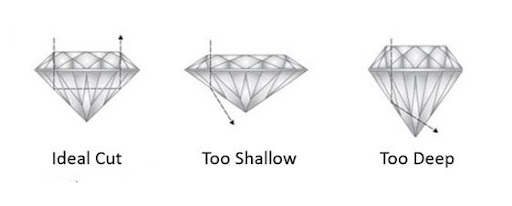
NOT ALL LABORATORIES GRADE TO THE SAME CUT GRADEPARAMETERS
The table below details the various laboratories and the different grading scales they use, you will notice that there is an over lap in some of the grades and that the top grade is not the same for each laboratory.
GIA and DCLA have Excellent as their top grade, HRD has Very Good for its top grade whilst AGS splits its top grade category into Ideal and Excellent.
DCLA & GIA have the same grade categories except DCLA calls its second lowest grade Medium whereas GIA calls it Fair. AGS has the same breakdown of catgeories as both DCLA & GIA except for the top grade of Excellent where it breaks down that category into two sections of Ideal - AGS0 and Excellent - AGS1.
AGS is the only Grading Laboraotory that actually has a grade called Ideal. The term Ideal Cut Diamond is a widely and quite oftenly misused marketing term used by Jewellers and Diamond Dealers to describe a cutting style based on proportions rather than an actual Ideal grade by a laboratory unless the diamond has been certified by AGS with and AGS grade of Ideal - AGS0
Diamond Cut Guide
The cut of a diamond refers to its proportions, symmetry and polish. These are the three main factors that affect the diamond's ability to return light. Another term that is used to describe a diamond's light performance is "brilliance".
A diamond that is ideally cut produces high light return, scintillation, fire and spectacular brilliance. A poorly cut diamond causes light to leak out the bottom or sides of the diamond, thereby minimizing the amount of light that is allowed to reutrn via the diamond's top and specifically its table. Even a diamond that has exceptional color and clarity can appear lifeless and dull when it is poorly cut. For this reason, The Diamond Vault suggests that you choose the diamond with the highest cut grade that falls within your budget.
The cut of a diamond can be assessed in three main areas::
- Brilliance: Brilliance refers to the overall amount of light that is returned by the diamond. When light hits the diamond's surface some of it enters and other is immediately returned, usually from the crown facets.
- Scintillation: Scintillation refers to the sparkles that are produced by the diamond when it is moved under a light. It is the diamond's "Disco-ball" effect as we commonly explain to our clients who visit us at The Diamond Vault.
- Fire: A diamond's fire refers to its ability to prism and disperse light into different colors of the color spectrum. Diamond's fire is usually seen in the primary colors of Red, Green and Blue, where different diamonds may show different levels of each depending on its particular fire attributes.
Diamond Cut by Shape
A diamond cut by shape describes the outline of the stone and pattern of the facet arrangement. A stone can be cut in various shapes like Round, Princess, Emerald, Oval, Marquise, Pear, Asscher, Radiant Heart, Cushion, Baguette, Trillion etc. We will further explore various diamond Shapes in the Shape section.
2) Diamond COLOR:
The GIA (Gemological Institute of America) colour grading classification starts from D, the finest colour grade (colourless), and continues through the alphabet to Z becoming progressively more tinted to yellow. A set of master comparison stones calibrated to the exact colour of every colour grade is the most reliable method of grading diamonds for colour. This allows for the accurate colour grading of the diamond.
Diamonds come in a variety of colors, some of them highly prized (pinks, blues, even yellow). However in a white diamond, the presence of a yellow tint will lower the price of a diamond. The less body color in a white diamond, the more true color it will reflect, and thus the greater its value.
Every Diamond has been assigned a color grade by the GIA ( Gemological Institute of America) in a viewing environment specially designed to eliminate color from surrounding surfaces as well as the light source itself. This allows the color of the diamond to be accurately measured. Minor differences in diamond color detected in this environment are very difficult if not impossible to detect in a normal environment. The diamond industry has adopted the GIA (Gemological Institute of America) diamond color scale; almost every diamond sold today is rated using the GIA color scale, whether it was actually certified by the GIA (Gemological Institute of America) or not.
The GIA (Gemological Institute of America) grades diamonds on a scale of D (colorless) through Z (light color). All D-Z diamonds are considered white, even though they contain varying degrees of color. True fancy colored diamonds (such as yellows, pinks, and blues) are graded on a separate color scale.
Below is the GIA (Gemological Institute of America) diamond color chart with definitions, accompanied by further explanatory comments from Diamond Bourse.
Diamond Color Grade Table
GIA (Gemological Institute of America) color Chart Grade:
Colorless (D,E,F)
A diamond that is absolutely colorless is incredibly rare. In fact, even the most expensive Diamonds used in Jewelry are typically not completely colorless. Diamond color grades start at the letter D, or absolutely colorless, and go all the way to the letter Z. Colorless Diamonds range from D to F. To the eye of an experienced jeweler, even one using magnification, a colorless diamond will have no visible coloring. The only colors you might see are the ones that are reflected through the light in the diamond's various facets. A colorless diamond is top of the line, although they are hard to find and afford because of their rarity.
Near Colorless (G,H,I,J)
Some Diamonds are virtually colorless, but close inspection reveals very subtle hints of yellow. In G or H near colorless Diamonds, these hints of yellow might only be visible under 10x magnification. Often, the only way to even pick up on these minor color issues is to compare a new colorless diamond to a D colorless diamond. Side by side, it might be easier to spot any imperfections in the color of the diamond. Near colorless Diamonds classed as I or J may have some yellow undertones that are visible to the unaided eye. Often, near colorless Diamonds are a great choice to pair with white or yellow gold.
Faint Yellow (K,L,M)
The next category of diamond color grades is faint yellow. Even to the untrained eye, these Diamonds are not colorless. Although the classification is yellow, it's important to note that these Diamonds might also appear slightly brown or even grey. While they aren't colorless, they can still be beautiful. These are typically a more affordable choice for buyers, often coming it at half the price of a E or F diamond. They look best in a warm setting like yellow gold. The clearest of the faint yellow Diamonds is classed as a K, followed by L and then M, which is the most yellow in this category.
Very Light Yellow (N,O,P,Q,R)
Very light yellow Diamonds are the next category of diamond color grades. Right away, looking at a very light yellow diamond will reveal that it is not colorless. Compared to a truly colorless diamond, a very light yellow diamond might look yellow, grey or brown. While these Diamonds are readily available, they are less common for engagement rings or high-end pieces. Nonetheless, they are typically an exceptional value because of reduced demand for this color. The subcategories of very light yellow Diamonds range from N to R, with N being the lighter in color and R being the darkest.
Light Yellow (S,T,U,V,W,X,Y,Z)
Technically, these Diamonds are still classified as white Diamonds. This makes them different from fancy color Diamonds, which might be a distinct color. However, light yellow Diamonds are obviously not colorless in any way. They are visibly a different color, and many people find the hues of these affordable Diamonds to be unappealing. In the right setting, perhaps with a yellow gold cup under the stone, a light yellow diamond can be colorful and eye-catching. You might have a hard time finding light yellow Diamonds in a Jewelry store simply because there is very limited demand for them. Light yellow Diamonds can be classified from S all the way to Z, with Z Diamonds being the darkest in color.
Fancy Colored Diamonds
Although majority of diamonds come in shades of white, there are also "Fancy" natural intensely colored diamonds available in colors like yellow, pink, greens, brown, red, orange, blue etc. These intensely colored diamonds are very rare, attractive and desirable. A deeply colored diamond can cost more than its colorless counterpart. These intensely colored diamonds are known as "Fancy" colored or "Fancies". Fancy colored diamonds are graded in two ways. The first factor is the basic hue, such as pink, yellow, blue, green, etc. The second is the intensity. Both color characteristics form the basis for determining a fancy colored diamond's worth. In fancy colored diamonds, a Z+ grade is used for their color grading. Usually, the more intense the color, the rare and expensive the diamond will be. For example, a fancy light pink diamond costs less than a fancy vivid pink diamond of equal size, shape and clarity. Though fancy colored diamonds rarely occur in nature, laboratories can easily create them through irradiation and heating. This process can permanently turn a natural colorless diamond into a fancy colored diamond. Treatments have also been developed to make lower-color white diamonds whiter. Irradiated colored diamonds have a significantly lower value than natural fancy diamonds and can be detected in a gem laboratory.
3) Diamond CLARITY:
Clarity is a term used to describe the absence or presence of flaws inside or on the surface of a diamond. In other words, the clarity of a diamond refers to a diamond's clearness or purity.
When these flaws / marks occur internally, they are called inclusions. The most common types of inclusions include crystals, (tiny bubbles representing small minerals that were absorbed into the diamond while it was growing), internal graining, needles, knots, chips, cavities, cleavage, feathers, and clouds. On the contrary, when these flaws / marks occur on the surface, they are known as blemishes. The most common types of blemishes include polish lines, naturals, scratches, nicks, pits, transparent stress lines that appear on a diamond's surface, surface graining, and extra facets. Blemishes are usually cut to remove a near-surface inclusion to raise the clarity grade of a stone. Most diamonds have these imperfections in them. Although many of these flaws are not visible to the naked eye, but under magnification, tiny featherlike shapes, crystals, bubbles and dark flecks become noticeable. These slight flaws make every diamond quite unique but they also affect the beauty and value of the diamond.
A diamond's clarity is based on the number, size, nature, and location of imperfections on the finished stone. A diamond with higher clarity is more valuable in comparison to a diamond that contains numerous inclusions because it is less brilliant, as the inclusions interfere with light passing through it.
Diamond Clarity Chart
Because they are formed deep within the earth, under extreme heat and pressure; virtually all diamonds contain "birthmarks"; small imperfections inside the diamond (called inclusions), or on its surface (called blemishes). Clarity refers to the degree to which these imperfections are present. Diamonds which contain numerous or significant inclusions or blemishes have less brilliance because the flaws interfere with the path of light through the diamond.
The position of an inclusion affects how easily it can be seen. Diamond cutters make every effort to cut a stone so that inclusions are not visible through the table of the finished diamond. The preferred position for inclusions is under the bezel facets or near the girdle because they are harder to see there.
Almost all diamonds are graded for clarity using the 11 point diamond clarity scale created by the GIA, including diamonds which were not actually graded by GIA certified. In grading diamond clarity, the GIA considers the number, size, color, reflectivity, and position of every flaw visible under 10x magnification.
3) Carat Weight:
Carat is the measure of how much a diamond weighs. Diamond carats is often denoted as “carats” or “ct.”.
What is a Carat ?
A carat is a type of weight measure. Diamonds, just like other kinds of gemstones, are weighed using the metric carats.
A carat equals two-tenths of a gram or 200 milligrams, (1 carat = 0.2 grams = 200 milligrams).
Each carat is then divided up into 100 total points. (1 carat = 100 points)
Therefore, a 50-point gemstone can be expected to weigh 0.50 carats or 1/2 of a carat.
The origin of carat weight and its acceptance as an industry standard
The origins of using the carat as a measurement of weight come from the early days of trading when carob seeds were used as counterweights to balance scales for gem traders. These seeds were generally a uniform weight, so their use was something everyone could agree on as a way of measuring weight. Over time, this evolved into the carat weights used today.
How is carat weight denoted ?
The abbreviation of "CT" is used specifically for carat, which refers to the weight of one diamond or gemstone. Example 1 carat will be denoted as 1 CT.
There are carat abbreviations that are single, and abbreviations that are used for total weight, some of them are explained below.
- CT = Carat Total. Also know as CW(Carat Weight)
- CTW = Carat Total Weight. Also knows as CWT(Carat Weight Total), TW(Total Weight) & TDW(Total Diamond Weight)
How is the diamond price calculated using carat?
The price of a diamond is calculated by multiplying the diamond carat weight by per carat price. Example if a diamond weighs 0.50 carats and the market price per carat is $2000/carat. Then the 0.50ct diamond will cost you $1000.
Total Carat Weight * Price Per Carat = Diamond Price
0.50ct * $2000 = $1000
Similary, if a diamond weighs 1.50 carats and the market price per carat is $4000/carat. Then the 1.50ct diamond will cost you $6000.
1.50ct * $4000 = $6000
How is the price per carat determined?
The price per carat varies based on the Diamonds characteristics. The base price per carat is determined using a combination of carat weight, clarity, and color. Other characteristics of the diamond such as cut, fluorescence, polish, etc. can add a premium or discount the base per carat price. The per carat price is dynamic and changes weekly varying based on the demand and supply of Diamonds available globally.
Carat Weight vs Price Per Carat
The price per carat is not a linear measure and multiplies exponentially. This is mostly because larger Diamonds are rarer than small ones. So a larger diamond does not only cost more. Its also costs more per carat.
Popular misconceptions about carat
The diffrence between Diamond Carat and Gold Karat
Carat is not to be confused with Karat. Carat, as explained above, is a weight unit of measure for Diamonds and gemstones, while karat is the measure of purity for the precious metal gold. Both of them are pronounced very similarly so one has to be careful when having a verbal discussion to be aware and know the difference. Carat is denoted as (ct) and Metal Karat is denoted as (k). Carat is also not to be confused with a carrot :




